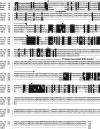Purification and Characterization of a Novel Extracellular Haloprotease Vpr from Bacillus licheniformis Strain KB111
- PMID: 35910276
- PMCID: PMC9295624
- DOI: 10.17113/ftb.60.02.22.7301
Purification and Characterization of a Novel Extracellular Haloprotease Vpr from Bacillus licheniformis Strain KB111
Abstract
Research background: Haloalkaline proteases are one of the most interesting types of commercial enzymes in various industries due to their high specific activity and stability under extreme conditions. Biochemical characterization of enzymes is an important requirement for determining their potential for application in industrial fields. Most of microbial proteases have been isolated from Bacillus spp. In this study, the purification and characterization of an extracellular haloprotease produced from Bacillus sp. KB111 strain, which was previously isolated from mangrove forest sediments, are investigated for industrial applications.
Experimental approach: The whole genome of KB111 strain was identified by DNA sequencing. Its produced protease was purified by salting out and anion-exchange chromatography, characterized based on protease activity and stability using a peptide substrate, and identified by LC-MS/MS.
Results and conclusions: The strain KB111 was identified as Bacillus licheniformis. The molecular mass of its extracellular protease, termed KB-SP, was estimated to be 70 kDa. The optimal pH and temperature for the activity of this protease were 7 and 50 °C, respectively, while the enzyme exhibited maximal activity in the broad salinity range of 2-4 M NaCl. It was fully stable at an alkaline pH range of 7-11 at 50 °C with a half-life of 90 min. Metal ions such as K+, Ca2+ and Mg2+ could enhance the enzyme activity. Therefore, this protease indicates a high potential for the applications in the food and feed industry, as well as the waste management since it can hydrolyse protein at high alkaline pH and salt concentrations. The amino acid profiles of the purified KB-SP determined by LC-MS/MS analysis showed high score matching with the peptidase S8 of B. licheniformis LMG 17339, corresponding to the mature domain of a minor extracellular protease (Vpr). Amino acid sequence alignment and 3D structure modelling of KB-SP showed a conserved catalytic domain, a protease-associated (PA) domain and a C-terminal domain.
Novelty and scientific contribution: A novel extracellular haloprotease from B. licheniformis was purified, characterized and identified. The purified protease was identified as being a minor extracellular protease (Vpr) and this is the first report on the halotolerance of Vpr. This protease has the ability to work in harsh conditions, with a broad alkaline pH and salinity range. Therefore, it can be useful in various applications in industrial fields.
Keywords: Bacillus sp.; Vpr; halophilic bacteria; serine protease; structural modelling.
Conflict of interest statement
CONFLICT OF INTEREST The authors have no conflict of interest to declare.
Figures






Similar articles
-
Purification and characterization of an extracellular haloalkaline serine protease from the moderately halophilic bacterium, Bacillus iranensis (X5B).Extremophiles. 2016 Mar;20(2):115-23. doi: 10.1007/s00792-015-0804-8. Epub 2015 Dec 23. Extremophiles. 2016. PMID: 26696418
-
Homology modeling and heterologous expression of highly alkaline subtilisin-like serine protease from Bacillus halodurans C-125.Biotechnol Lett. 2021 Feb;43(2):479-494. doi: 10.1007/s10529-020-03025-6. Epub 2020 Oct 12. Biotechnol Lett. 2021. PMID: 33047274
-
Detergent-, solvent- and salt-compatible thermoactive alkaline serine protease from halotolerant alkaliphilic Bacillus sp. NPST-AK15: purification and characterization.Extremophiles. 2015 Sep;19(5):961-71. doi: 10.1007/s00792-015-0771-0. Epub 2015 Jul 10. Extremophiles. 2015. PMID: 26159877
-
Extracellular proteases from halophiles: diversity and application challenges.Appl Microbiol Biotechnol. 2023 Oct;107(19):5923-5934. doi: 10.1007/s00253-023-12721-y. Epub 2023 Aug 11. Appl Microbiol Biotechnol. 2023. PMID: 37566160 Review.
-
Microbial Proteases Applications.Front Bioeng Biotechnol. 2019 Jun 12;7:110. doi: 10.3389/fbioe.2019.00110. eCollection 2019. Front Bioeng Biotechnol. 2019. PMID: 31263696 Free PMC article. Review.
Cited by
-
Comprehensive biochemical, molecular and structural characterization of subtilisin with fibrinolytic potential in bioprocessing.Bioresour Bioprocess. 2025 Mar 21;12(1):21. doi: 10.1186/s40643-025-00860-1. Bioresour Bioprocess. 2025. PMID: 40117024 Free PMC article.
-
Antimicrobial Potential of Secondary Metabolites Produced by Bacillus sp. and Their Gas Chromatography (GC)-Mass Spectrometry (MS) Analysis.Cureus. 2024 Sep 29;16(9):e70472. doi: 10.7759/cureus.70472. eCollection 2024 Sep. Cureus. 2024. PMID: 39479095 Free PMC article.
-
Establishment of the CRISPR-Cpf1 gene editing system in Bacillus licheniformis and multiplexed gene knockout.Synth Syst Biotechnol. 2024 Aug 8;10(1):39-48. doi: 10.1016/j.synbio.2024.08.002. eCollection 2025. Synth Syst Biotechnol. 2024. PMID: 39224148 Free PMC article.
-
Microbial-derived salt-tolerant proteases and their applications in high-salt traditional soybean fermented foods: a review.Bioresour Bioprocess. 2023 Nov 18;10(1):82. doi: 10.1186/s40643-023-00704-w. Bioresour Bioprocess. 2023. PMID: 38647906 Free PMC article. Review.
References
LinkOut - more resources
Full Text Sources
Miscellaneous
